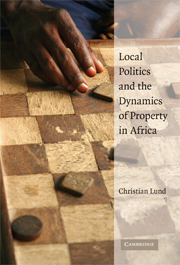Book contents
- Frontmatter
- Contents
- List of Maps, Figures, and Tables
- Acknowledgments
- Abbreviations
- Map 1 The Gold Coast, 1907
- Map 2 Regions of Ghana since 1983
- 1 Introduction
- 2 “This Situation Is Incongruous in the Extreme”: The History of Land Policies in the Upper Regions of Ghana
- 3 Who Owns Bolgatanga? The Revival of the Earthpriest and Emerging Tensions over Property
- 4 Seizing Opportunities: Chieftaincy, Land, and Local Administration
- 5 Settled Facts or Facts to Settle: Land Conflicts under Institutional Uncertainty
- 6 “Bawku Is Still Volatile”: Ethnopolitical Conflict and State Recognition
- 7 The Rent of Nonenforcement: Access to Forest Resources
- 8 Small Dams and Fluid Tenure
- 9 Conclusion
- References
- Index
6 - “Bawku Is Still Volatile”: Ethnopolitical Conflict and State Recognition
Published online by Cambridge University Press: 25 July 2009
- Frontmatter
- Contents
- List of Maps, Figures, and Tables
- Acknowledgments
- Abbreviations
- Map 1 The Gold Coast, 1907
- Map 2 Regions of Ghana since 1983
- 1 Introduction
- 2 “This Situation Is Incongruous in the Extreme”: The History of Land Policies in the Upper Regions of Ghana
- 3 Who Owns Bolgatanga? The Revival of the Earthpriest and Emerging Tensions over Property
- 4 Seizing Opportunities: Chieftaincy, Land, and Local Administration
- 5 Settled Facts or Facts to Settle: Land Conflicts under Institutional Uncertainty
- 6 “Bawku Is Still Volatile”: Ethnopolitical Conflict and State Recognition
- 7 The Rent of Nonenforcement: Access to Forest Resources
- 8 Small Dams and Fluid Tenure
- 9 Conclusion
- References
- Index
Summary
The intention is to make sense, not discredit.
It's true that things aren't always what they seem,
but what they seem is always part of what they are.
Louis Menand, American StudiesIntroduction
Ethnopolitical clashes have marred northern Ghana for decades (Brukum, 2000, 2001; Drucker-Brown, 1988, 1994). Bawku in the Upper East Region has been the scene of repeated confrontations – some very violent, others less so – between Mamprusis and Kusasis. The latest violence occurred in 2001 and 2002 in relation to local elections and the appointment of a local district chief executive. This chapter analyzes the longue durée of this ethnopolitical conflict and the role and idea of the state in this connection.
Ethnopolitical violence and competition, it is argued, are increasingly challenging the African state. The inability to put communal violence definitively to rest, or deal with it in appropriate institutional fora, is threatening the central state authority. Scholars of African, and indeed Ghanaian, politics often see the unruly politics based on the rhetoric of ethnicity (chiefly pedigree), firstcomers' rights, autochthony, and historical rights and injustice as testimony to the incapacity of the modern, secular, nation-state based on universal citizenship and equality (Akwetey, 1996; Skalník, 2002). Akwetey argues that the absence of adequate democratic institutions is to blame for the recurrent outbreaks of violence; there are simply no channels for expressing interests and demands.
- Type
- Chapter
- Information
- Local Politics and the Dynamics of Property in Africa , pp. 108 - 133Publisher: Cambridge University PressPrint publication year: 2008

